All the solutions provided in McGraw Hill My Math Grade 5 Answer Key PDF Chapter 7 Lesson 5 Generate Patterns will give you a clear idea of the concepts.
McGraw-Hill My Math Grade 5 Answer Key Chapter 7 Lesson 5 Generate Patterns
Build It
The pattern below is made from toothpicks. The first figure uses 4 toothpicks, the second figure uses 7 toothpicks, and the third figure uses 10 toothpicks. Assume the pattern continues.

1. Use toothpicks to model the fourth figure. How many toothpicks did you use?
Answer:
13 tooth picks.
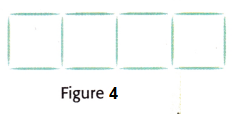
Explanation:
To model the fourth figure we need 13 tooth picks.
The pattern follows as shown below;
The first figure uses 4 toothpicks,
the second figure uses 7 toothpicks, 4 + 3 = 7
the third figure uses 10 toothpicks, 7 + 3 = 10
the fourth figure uses 13 toothpicks, 10 +3 = 13
2. Use toothpicks to model the fourth figure. How many toothpicks did you use?
3 more tooth picks to the existing figure 3.
Answer:

To model the fourth figure we need 13 tooth picks.
The pattern follows as shown below;
The first figure uses 4 toothpicks,
the second figure uses 4 + 3 = 7 tooth picks.
the third figure uses 7 + 3 = 10 tooth picks.
the fourth figure uses 10 +3 = 13 tooth picks.
3. Complete the table to show the number of toothpicks needed if the pattern continues.

What do you notice about the number of toothpicks needed for each new figure?
Answer:

Explanation:
The number of toothpicks needed to continue the pattern follows as,
n + 3 ( where as n is the initial tooth picks of figure 1)
Figure1: 4 tooth picks.
Figure 2: 4 + 3 = 7 tooth picks.
Figure 3: 7 + 3 = 10 tooth picks.
Figure 4: 10 + 3 = 13 tooth picks.
Figure 5: 13 + 3 = 16 tooth picks.
Figure 6: 16 + 3 = 19 tooth picks.
Figure 7: 19 + 3 = 21 tooth picks.
Talk About It
Question 1.
Using your rule, how many toothpicks would be needed for the eighth figure? ninth figure?
Figure 8 ___________
Figure 9 ___________
Answer:
Figure 8 need 24 tooth picks.
Figure 9 need 27 tooth picks.

Explanation:
Rule = n + 3
As shown above figure 7 need 21 tooth picks.
So, figure 8 and 9 need 24 and 27 tooth picks.
21 + 3 = 24
24 + 3 = 27
Question 2.
Mathematical PRACTICE Use Math Tools Create a new pattern. Start with Figure 1 again. Add 6 toothpicks for each new figure as shown. Complete the table to show the number of toothpicks used for each figure.
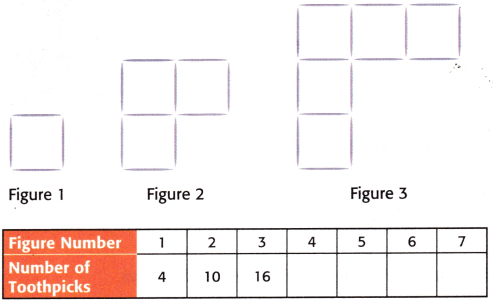
Answer:

Explanation:
Pattern start with Figure 1 with 4 tooth picks.
We need to Add 6 toothpicks for each new figure as shown above.
Rule: n + 6
Figure1: 4 tooth picks.
Figure 2: 4 + 6 = 10 tooth picks.
Figure 3: 10 + 6 = 16 tooth picks.
Figure 4: 16 + 6 = 22 tooth picks.
Figure 5: 22 + 6 = 28 tooth picks.
Figure 6: 28 + 6 = 34 tooth picks.
Figure 7: 34 + 6 = 40 tooth picks.
Question 3.
Compare the pattern in Exercise 2 to the pattern in the activity on the previous page.
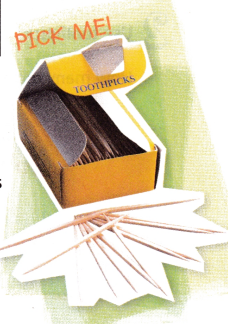
The number of toothpicks in Figure 2 for the pattern on the previous page is ____________ less than the number of toothpicks in Figure 2 for the pattern in Exercise 2.
The number of toothpicks in Figure 3 for the pattern on the previous page is ___________ less than the number of toothpicks in Figure 3 for the pattern in Exercise 2.
Answer:
The number of toothpicks in Figure 2 for the pattern on the previous page is 3 less than the number of toothpicks in Figure 2 for the pattern in Exercise 2.
The number of toothpicks in Figure 3 for the pattern on the previous page is 6 less than the number of toothpicks in Figure 3 for the pattern in Exercise 2.
Explanation:
Pattern in previous page follows the rule as n + 3,
where as pattern in exercise 2 follows the rule as n + 6.
figure 2 in previous page is 4 + 3 = 7
figure 2 in exercise 2 is 4 + 6 = 10
when we compare both the figures 10 – 7 = 3
So, 3 less tooth picks than the second one.
Pattern in previous page follows the rule as n + 3,
where as pattern in exercise 2 follows the rule as n + 6.
figure 3 in previous page is 7 + 3 = 10
figure 3 in exercise 2 is 10 + 6 = 16
when we compare both the figures 16 – 10 = 6
So, 6 less tooth picks than the second one.
Practice It
Mathematical PRACTICE Look for a Pattern For each pattern, find the number of toothpicks needed for the next figure.
Question 4.

Figure 4 needs ___________ toothpicks.
How is this pattern different than the pattern in the activity on the first page of this lesson?
Answer:
Figure 4 needs 10 tooth picks.
Pattern follows n + 2 rule.

Explanation:
The pattern in the activity on the first page of this lesson follows n + 3 rule,
where as the above pattern follows n + 2 rule.
Question 5.

Figure 4 needs ____________ toothpicks.
Answer:
Figure 4 needs 2 toothpicks.

Explanation:
The above pattern follows n + 2 rule,
figure 1 : 3 tooth picks.
figure 2: 3 + 2 = 5
figure 3: 5 + 2 = 7
figure 4: 7 + 2 = 9
Question 6.
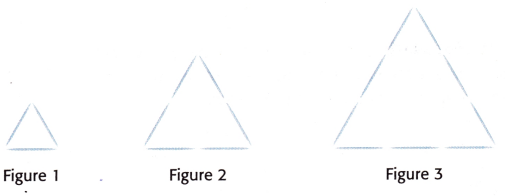
Figure 4 needs ___________ toothpicks.
How does this pattern compare to the pattern for Exercise 5?
Answer:
Figure 4 needs 12 toothpicks.

Explanation:
The above pattern follows the n + 3 rule.
Figure 1: 3
Figure 2: 3 + 3 = 6
Figure 3: 6 + 3 = 9
Figure 4: 9 + 3 = 12
When we compare the pattern for Exercise 5 and Exercise 6,
2 tooth picks are added in exercise 5 and 3 are added in exercise 6.
Apply It
Question 7.
The tables show the number of laps Tammi and Kelly swim each day. Complete each table if the patterns continue.

Compare the number of laps swam by each person on each day.
Answer:
Compare the number of laps swam by each person on each day,
Tammi swim 3 laps more than Kelly.
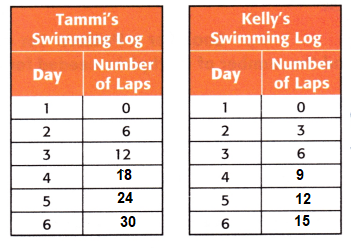
Explanation:
The number of laps Tammi follow the pattern of n + 6 laps.
First day = 0 laps.
Second day = 0 + 6 = 6 laps.
Third day = 6 + 6 = 12 laps.
Fourth day = 12 + 6 = 18 laps.
Fifth day = 18 + 6 = 24 laps
Sixth day = 24 + 6 = 30 laps.
The number of laps Kelly follow the pattern of n + 3 laps.
First day = 0 laps.
Second day = 0 + 3 = 3 laps.
Third day = 3 + 3 = 6 laps.
Fourth day = 6 + 3 = 9 laps.
Fifth day = 9 + 3 = 12 laps
Sixth day = 12 + 3 = 15 laps.
Question 8.
Two stores sell scented candles. Assume the pattern in the table below continues. Compare the price of candles sold by each store.

Answer:
Price of candles sold by the store 1 is double than the store 2.
Explanation:
Store 1 sells each candle for $4,
it follows the pattern as n + 4.
2 candles cost = 4 + 4 = $8
3 candles cost = 8 + 4 = $12
4 candles cost = 12 + 4 = $16
Store 2 sells each candle for $2,
it follows the pattern as n + 2.
2 candles cost = 2 + 2 = $4
3 candles cost = 4 + 2 = $6
4 candles cost = 6 + 2 = $8
When we compare the price of candles sold by the stores,
store1 sold the candles for double price than the store 2.
Question 9.
Mathematical PRACTICE Model Math Use Figure 1 of Exercise 5 to create a different pattern using toothpicks. Draw the pattern below. How does your pattern compare to the pattern in Exercise 5?
Answer:

The pattern in Exercise 5 is shown below.

Explanation:
In Exercise 5 and Exercise 9 follows same n + 2 rule, but patterns are different.
figure 1 : 3 tooth picks.
figure 2: 3 + 2 = 5
figure 3: 5 + 2 = 7
figure 4: 7 + 2 = 9
Write About It
Question 10.
How can models be used to generate and analyze patterns?
Answer:
A pattern is something that follows a specific rule.
Patterns can be generated by using a repeated arrangement of numbers, shapes, colors etc., Explanation:
We know that the set of numbers related to each other in a specific rule,
then the rule or manner is called a pattern.
Sometimes, patterns are also known as a sequence.
Recognizing mathematical patterns consists of observing patterns within the given data. Solving patterns involves making predictions or extending the pattern based on the pattern recognized.
McGraw Hill My Math Grade 5 Chapter 7 Lesson 5 My Homework Answer Key
Practice
Mathematical PRACTICE Look for a Pattern For each pattern, draw toothpicks to find the number of toothpicks needed for the next figure.
Question 1.

Figure 4 uses __________ toothpicks.
Answer:
Figure 4 uses 9 toothpicks.

Explanation:
The above pattern follows n + 2 rule,
figure 1 : 3 tooth picks.
figure 2: 3 + 2 = 5 tooth picks.
figure 3: 5 + 2 = 7 tooth picks.
figure 4: 7 + 2 = 9 tooth picks.
Question 2.

Figure 4 uses ___________ toothpicks.
How does this pattern compare to the pattern for Exercise 1?
Answer:
Figure 4 uses 12 toothpicks.

Explanation:
When we compare this pattern with Exercise 1 it follows n + 3 rule.
figure 1 : 3 tooth picks.
figure 2: 3 + 3 = 6 tooth picks.
figure 3: 6 + 3 = 9 tooth picks.
figure 4: 9 + 3 = 12 tooth picks.
Problem Solving
Question 3.
The tables show the height in centimeters each plant grew during a week. Assume the patterns continue. Compare the growth in height of each plant.
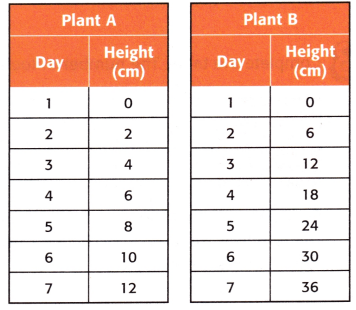
Answer:
The growth in height of each plant doubles every day.
Explanation:
In plant A the growth in height follows the pattern as n + 2,
where as in plant B growth in height follows the pattern as n + 6.
So, if observe the growth in height of both the plants it doubles its height each day then the previous day.